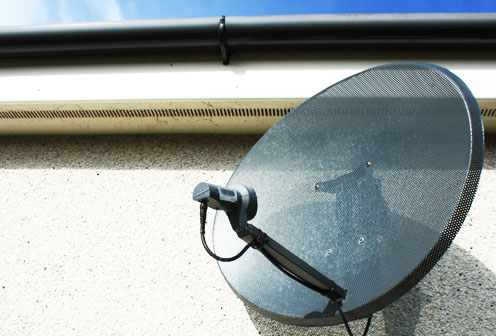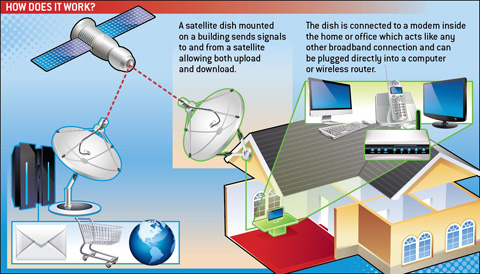Broadband solutions – satellite

Satellite broadband is one of the most popular choices for farmers who cannot get a normal connection. It has a reputation for being expensive and slow, but a new satellite launched least year means it is now a solid contender, as Robyn Vinter finds out.
How does it work?
A satellite dish mounted on a building sends signals to and from a satellite allowing both upload and download.
The dish is connected to a modem inside the home or office which acts like any other broadband connection and can be plugged directly into a computer or wireless router.

Costs
The monthly costs have reduced dramatically in the last year due to a new satellite, Eutelsat’s KA-SAT, which was launched in June. Tooway Direct, for example, charges between £24.99 a month for 6Mbps and £80 for 10Mbps. There is a one-off equipment cost of £149, but customers on the higher tariffs get the kit free.
Permissions
The satellite dish measures 76cm across and planning permission is only required for dishes larger than 1m. Permission must be sought, however, if the house or office is a listed building.
Benefits
- costs, speeds and reliability greatly improved
- can be up and running within 48 hours of signing up
- easily self-installed (or £96 to be fitted by an engineer with Tooway Direct)
- grants schemes for businesses in Wales, Devon and Somerset cover installation costs
- availability and service quality is the same no matter how remote the location.
Downsides
- slightly more expensive than major providers for standard connections and other methods
- some satellite broadband suppliers do not support television catch-up services like BBC iPlayer, because they cannot provide a UK IP address
Legal issues
Contracts can be carried over to a new property and equipment is easy to move, but customers must inform their satellite broadband provider so they can do any necessary licensing checks with Ofcom. If a user fails to do this, they may be fined if their connection interferes with other licensed equipment nearby.
Speeds
Satellite is capable of producing speeds of up to 50Mbps.
What do you need?
The satellite dish should be roughly south-facing and can be mounted on a wall or roof of a home or office, or failing this, attached to a post. It must be absolutely rigid though, as even a 1mm movement can have an effect on the signal. This means that wooden structures are not suitable, as they expand and contract with seasonal temperature changes. For customers fitting a dish for themselves, the equipment now offers a guide for correct positioning based on a beeping sound.
Range
Satellite broadband can be accessed anywhere in the UK, no matter how remote, and is suitable for providing a connection to a number of buildings at a time.
How many people can use it?
The current satellite used by most providers can support one million people in Europe. Per satellite dish, the connection is similar to a standard ADSL connection – enough for a small office of several people.
How do I go about it?
Many satellite broadband providers offer trials or displays of the technology, allowing potential customers to get to grips with how it works before signing up to it.
Case study
John Sykes
Denby Dale, Huddersfield
For many businesses with satellite broadband, the benefits far outweigh the cost. John Sykes runs an 800ha mixed farmland and woodland estate in West Yorkshire with 600ha of tenanted and in-hand farmland and has satellite broadband with Avonline. He pays £50 a month for 10Mbps.

“The connection offers us the flexibility to do anything and everything we need and the cost is negligible compared to the benefits,” he said.
“It makes us competitive and means we can manage the business effectively. Before this I couldn’t even send a simple photo but now I can receive, amend and send back documents without any trouble. If I email someone, I can get a response in the blink of an eye. Since I’ve had it I’ve never looked back.
“[Satellite broadband companies are] a wonderful example of private enterprise filling a gap which, because of all the bureaucracy surrounding broadband delivery, it seems the government can do little about. The promise the government has made about everyone having broadband by 2015 doesn’t help, because business cannot afford to wait.
“Being cut off or isolated is no longer a penalty of living in a rural area.”
Are you using a different method? Let us know at www.fwi.co.uk/broadband, tweet @robynvinter and @farmersweekly using #fwbroadband or send an email to Robyn Vinter
For more on this topic
Visit our broadband campaign pages
